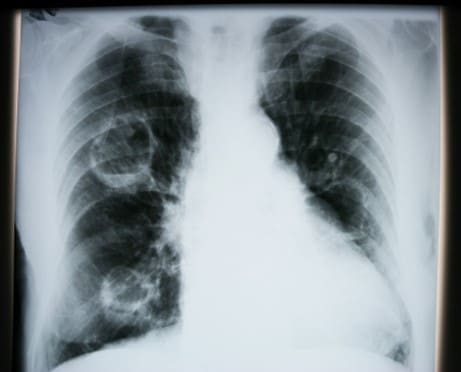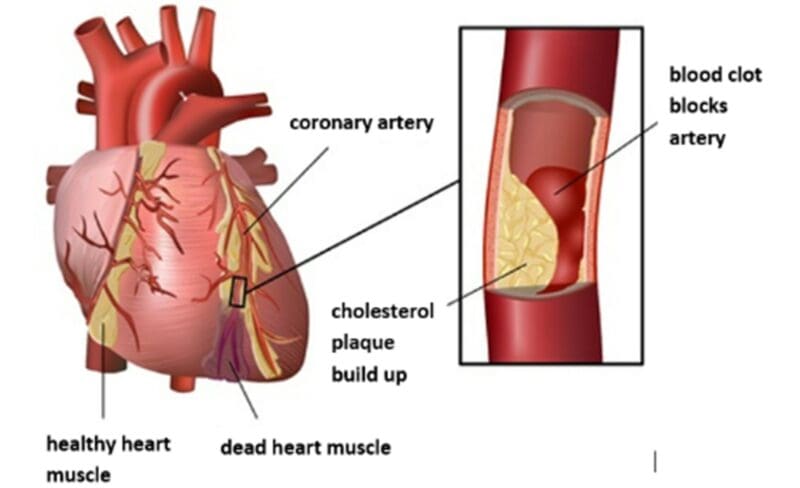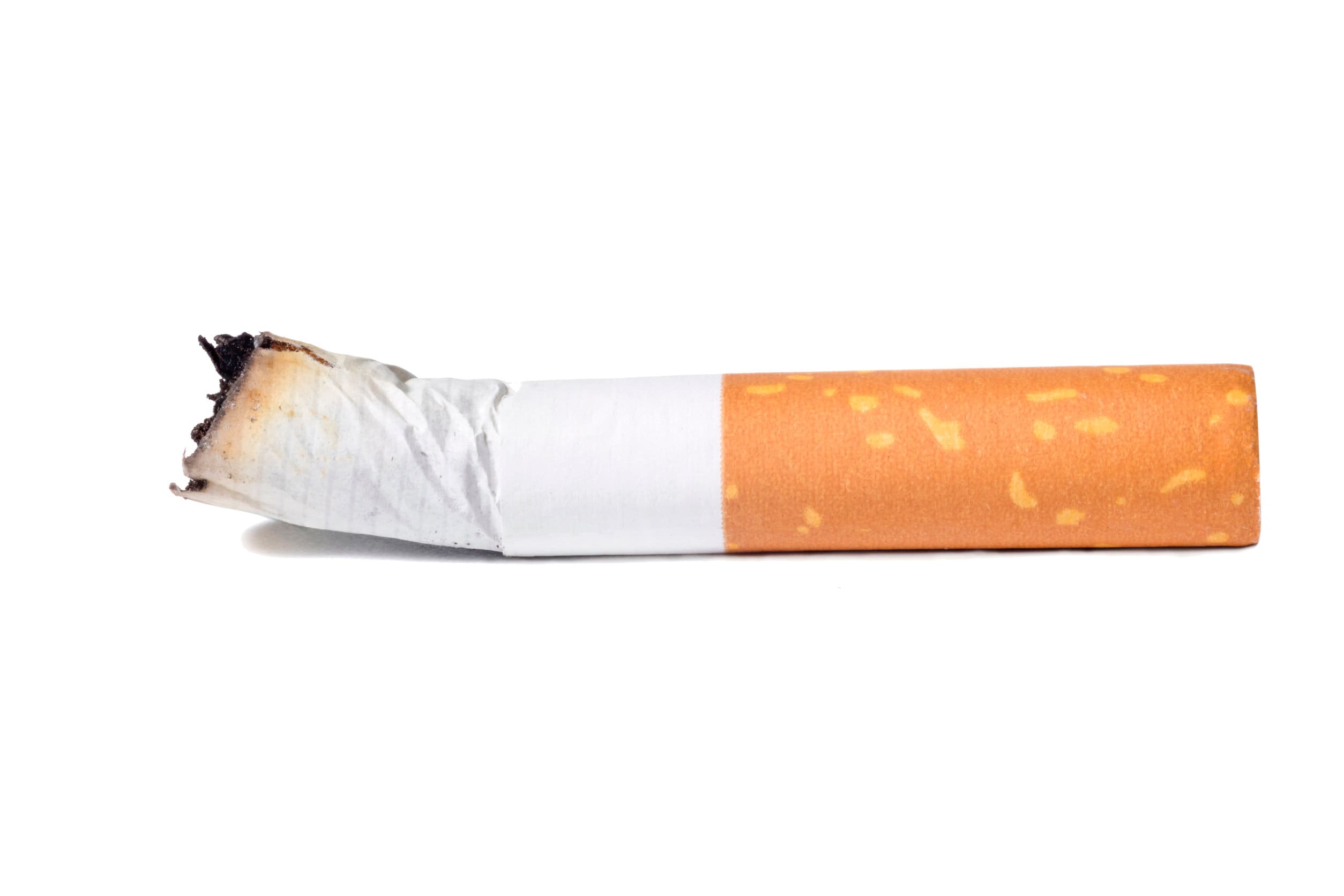In this post
A single cigarette contains thousands of different chemicals, the majority of which are harmful to the human body.
Smoking affects the lungs’ ability in being able to exchange gases properly. Smoking causes dirt particles and bacteria to build up on the alveoli. Alveoli require as big a surface area as possible and the build-up of dirt and particles decreases the surface area, causing a decrease in oxygen being able to diffuse into the blood.
The chemicals in cigarette smoke destroy the cilia in the trachea and the bronchi, leading to dirt particles and bacteria to be free to get into the lungs. There is also the secretion of more mucus because the cigarette smoke irritates the lining of the airways which stimulates the cells to secrete more. The damaged and reduced number of cilia means that the mucus secreted is not swept away from the lungs and out towards the mouth; instead, it remains, clogging the air passages. This is the source of a ‘smoker’s cough’.
Research shows that smoking has significant links to a number of diseases and health conditions, for example bronchitis, emphysema and lung cancer.
Bronchitis
Bronchitis is a disease of the bronchi (the main airways in the lungs). Bronchitis occurs because of the irritation to the bronchial tree that smoking causes and because the lungs are not protected from contracting an infection from bacteria. This causes the bronchial tree to become irritated and inflamed, resulting in breathing difficulties for the sufferer.
Emphysema
Emphysema is a condition where smoke damages the walls of the alveoli. Due to the damaged alveoli, they break down but then fuse together again which causes enlarged and irregular air sacs; some have holes that trap the inhaled air instead of diffusing the oxygen into the bloodstream. The alveoli become less efficient due to the reduction in the surface area for gas exchange. Because of this, less oxygen is diffused into the blood, preventing cells and organs receiving the right amount of oxygen that they require to function properly. In more serious cases of emphysema, sufferers may be unable to carry out even mild exercise, for example walking. Patients suffering with severe cases of emphysema often always have an oxygen supply nearby. There is no cure for this disease and so it often results in death but only after a long and distressing illness.
Emphysema is a lung disease that is known to kill around 20,000 people in Britain every year.
Chronic obstructive pulmonary disease (COPD)
When persistent cases of bronchitis and emphysema occur together, a person can develop chronic obstructive pulmonary disease (COPD). This disease describes a number of lung conditions that can make it difficult to inhale and exhale air into and out of the lungs because of the narrowing of the airways. It is called chronic obstructive pulmonary disease because:
- Chronic refers to something that is a long-term condition and does not go away
- Obstructive refers to the narrowed airways, making it harder for a person to breath in and out
- Pulmonary refers to it affecting the lungs
- Disease refers to it being a medical condition
Look at the following diagram which illustrates what has happened to a person’s airways with COPD.

Lung cancer
Lung cancer is the uncontrolled growth of abnormal cells that can start in either one, or in both, of the lungs. These abnormal cells usually occur in the cells that line the air passage. Tumours develop as the abnormal cells divide rapidly.
A link between smoking and lung cancer was first discovered in the 1950s. Research was conducted by asking a certain number of patients lifestyle questions. The patients asked included a strict number suffering from lung cancer and the same number of patients suffering from illnesses other than lung cancer. To make it a fair comparison, the people in the other illnesses category were matched to a lung cancer patient with the same gender, age and other factors.
The results showed that a significant number of lung cancer patients smoked compared to their patient counterparts suffering from other illnesses. Although the study could not prove a medical reason, the study proved that there was a statistical link between smoking and lung cancer patients (a statistical link is known as a correlation). After this, a number of other studies were conducted around the world and are still being conducted today to prove the extent to which smoking not only causes lung cancer but also other cancers. The below image shows an X-ray taken of someone suffering from lung cancer.

Smoking also has links to other conditions such as coronary heart disease (which we will discuss in more detail shortly) and ulcers in the stomach and duodenum.
Smoking during pregnancy is dangerous for the foetus as it negatively affects the amount of oxygen in the blood, and as a result the baby does not receive enough oxygen that they require. Studies have shown that women who smoke during pregnancy are more likely to give birth to underweight babies and even premature babies.
Nicotine
Nicotine is one of the substances in a cigarette. It is a toxic colourless, or sometimes yellowish, oily liquid which is the primary component in tobacco. It is the addictive component of a cigarette which makes it hard for people to quit smoking once they have started.
Carcinogens
Carcinogens are chemicals that are known to cause cancer. Cigarette smoke is known to contain at least 17 of these chemicals which are contained in the tar that collects in a smoker’s lungs. Cancer occurs when cells mutate and begin to divide uncontrollably which results in a tumour forming. In some cases, if the tumour is still localised then it can be removed through surgery; however, if the cancer has spread to other areas of the body (known as a cancer metastasising) the tumour cannot be removed and it may be too late. One of the most fatal aspects of lung cancer is that tumours forming in the lungs do not usually cause any pain which means they are often only discovered when the cancer has spread beyond the lungs and is too late to treat.

You are not guaranteed to get lung cancer because you smoke. Some people have never smoked in their lives but have lung cancer; whilst others smoke a pack of cigarettes a day and never get lung cancer. However, the risk of lung cancer is much greater if you do smoke. The risk also increases depending on how many cigarettes you smoke a day.
The key advice is to not start smoking at all. However, if you are a smoker then giving up the habit soon can significantly increase a person’s risk of not getting lung cancer and other cancers that are known to be related to smoking. In actual fact, it is shown that after a few years of not smoking, the risk of a person dying from a smoking-related disease or cancer is almost back to the level of a non-smoker.
Take a look at the following graph which indicates the likelihood of a person dying from lung cancer depending on how many cigarettes they smoke per day.

Carbon monoxide (CO)
The other, very toxic chemical contained in cigarette smoke is the poisonous gas carbon monoxide. Oxygen is carried around the blood in red blood cells. Haemoglobin is a natural chemical that is present in the blood; oxygen is able to attach to this chemical and this is how it is carried around the body. However, carbon monoxide combines with haemoglobin much easier and more tightly than oxygen can so when this chemical is inhaled through cigarette smoke, haemoglobin will combine with carbon monoxide in preference to oxygen, which results in a lack of oxygen in the blood. When carbon monoxide combines with haemoglobin like this it forms a compound known as carboxyhaemoglobin. Exposure to carbon monoxide from smoking is also a major cause of heart disease.
Coronary heart disease (CHD)
Smoking is a major contributing factor to coronary heart disease. Coronary heart disease is the term that describes what happens when the heart’s blood supply is blocked due to a build-up of fatty substances in the coronary arteries. Over a period of time, the walls of the heart’s arteries become clogged with fatty deposits; this process is called atherosclerosis.
Look at the following diagram which illustrates what a heart suffering from CHD looks like.

Coronary heart disease is a major cause of death throughout the world. It is estimated that in the UK, 1 in 6 men and 1 in 10 women die from CHD each year. Although this disease generally affects more men than women, from the age of 50 the chances of developing this condition are the same for both genders.
Smoking statistics
In 2014, it was recorded that 19% of adults in Great Britain currently smoked; this was down from a peak of 46% in 1974.
In the same year, 18% of secondary school pupils reported that they had tried smoking at least once.
It was reported in 2014 that there were 78,000 deaths which were thought to be attributed to smoking.
In 2015, it was reported that 4% of adults in Great Britain were current e-cigarette users.
In the same year, 22% of secondary school pupils admitted to having tried an e-cigarette at least once.



